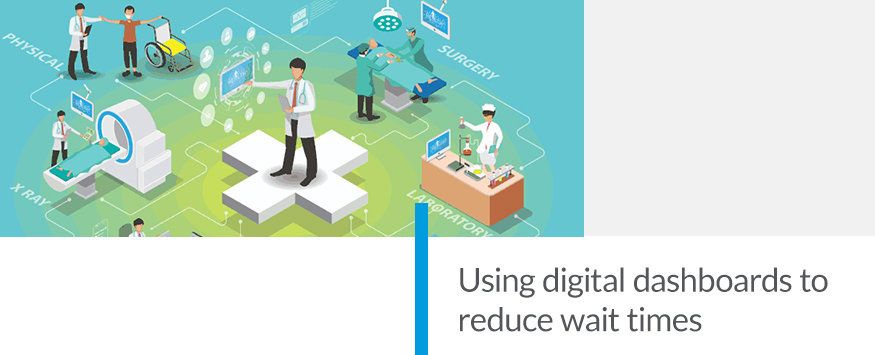Using Digital Dashboards to Reduce Patient Wait Times
By John Palmer
Featured in Patient Safety and Quality Healthcare
DECEMBER 2, 2019 – It will be a while before computers can replace physicians, but they are certainly working together to help improve the patient safety experience.
So-called “digital dashboards” are popping up everywhere, ranging from apps that allow primary care physicians (PCP) to collaborate easier with specialists without a face-to-face consult to centralized resources that help patients get information on their condition and reach out to the support services they need.
Known in the industry as e-consultations, telemedicine platforms help connect PCPs with specialists to help improve care management and care coordination for patients. The services are being touted as a cost-effective way to expand access to care and improve outcomes, as well.
“We know providers are pressed for time, and health systems are trying to streamline technology solutions, ideally with a single touchpoint,” says Brooke LeVasseur, CEO of La Jolla, California–based AristaMD. The company recently announced that AristaMD is now available on the Epic App Orchard, a marketplace of medical apps and e-consultation services.
“The AristaMD app in the App Orchard allows organizations to leverage our eConsult platform directly through their EHR with the benefits of baseline data, proven efficacy, full reporting, and platform management,” notes LeVasseur. “It’s an important step and part of our continued innovation plan focused on helping providers reduce the challenges of change management and, ultimately, provide better care for patients.”
AristaMD claims that its eConsult solution improves access to timely specialty care for patients who would have otherwise had to wait for a separate face-to-face visit. The AristaMD app makes the process easier for health system specialists using the Epic marketplace. Providers simply launch the eConsult platform directly through Epic’s electronic health record (EHR), creating a user-friendly experience for answering eConsults with minimal provider burden and workflow changes.
Some might argue that this technology replaces consulting with a human face-to-face. Still, in reality, the ability to have an electronic consultation with a doctor will become more important in the future as the medical industry faces a physician shortage and specialists. A 2017 report from the Association of American Medical Colleges predicts that the shortage of non–primary care specialists will surge to between 33,500 and 61,800 by 2030. In addition, having an electronic consultation option helps doctors and patients out by saving the time and cost of unnecessarily seeing a specialist.
“Medicine is changing along with technology,” says Denise Yvonne Gomez, MD, physician at North County Health Services in Oceanside, California, and a user of AristaMD. “Any health technology literature predicts most visits will eventually be virtual in one way or another. The fact is that there are not enough providers to see as many patients who need care, and therefore we need technology to help. E-consultation represents one of the many methods that technology can help provide quality of care to our patients.”
Gomez says that in the San Diego area where she practices, it takes three to four months for a Medicaid HMO-insured patient to receive a neurology evaluation. As a provider, she can use an e-consultation to give a neurologist her patient’s symptoms and test results and then obtain recommendations for further testing and possibly the initiation of treatment.
“The patient and family are comforted that the patient is receiving an active evaluation rather than just waiting months for an appointment,” she says. “In addition, if the patient does need a face-to-face with the specialist, much of the workup has been done, and the evaluation may be more meaningful, results in a reduction of duplicated testing, and subsequently saves costs.”
Helping Reduce Infections
While AristaMD’s solutions seek to facilitate the relationship between physicians and specialists and thereby improve patient experiences, other companies are developing systems to streamline the day-to-day operations within the walls of the hospital itself.
How Telehealth and eConsults Are Reducing Patient Wait Times
By Brooke LeVasseur, CEO, AristaMD
Featured in Electronic Health Reporter, Patient Safety and Quality Healthcare, and Inside Digital Health
Innovative healthcare solutions are invaluable to efforts of reducing patient wait times as healthcare systems face challenges in patient access and availability of care. As a result, telehealth solutions, such as eConsults, increase the efficiency of care by improving access to specialists while also better optimizing time and place of care.
The shortage of specialist physicians in the United States continues to receive a great deal of attention as an area of concern. However, a lesser-known compounding factor is the increase in referral rates. In a 2012 study, the National Ambulatory Medical Care Surveys found that between 1999 and 2009, the probability of receiving a specialist referral during an ambulatory patient visit increased from 4.8% to 9.3%, a 92% increase, nearly double.


